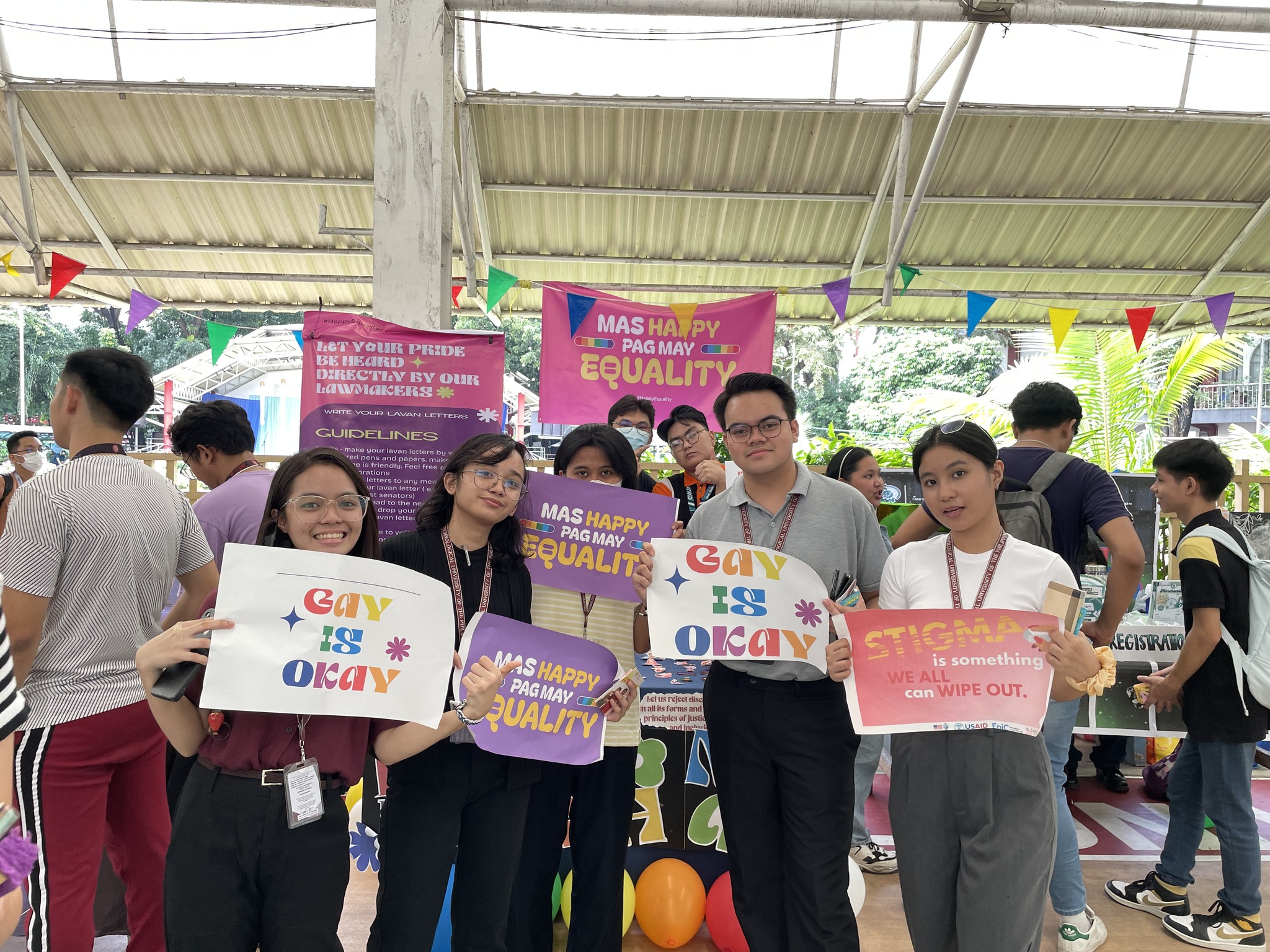Even as more Filipino people tolerate the LGBTQIA+ community according to studies, the landscape of public acceptance remains complex with ongoing challenges—particularly with the significant discrimination in educational institutions.
Last August 18, the Technological University of the Philippines faced backlash from students and netizens following its conservative policies on hair and dress codes.
The University Student Government (USG), however, was quick to take down the post after receiving intense criticism from individuals expressing their utmost disappointment.
In the now-deleted USG post, the policy outlined the implementing regulations for dress code which prohibited shorts, sleeveless shirts, slippers, long hair for males, colored hair for both genders, and cross-dressing.
Many argued that such a policy threatens progress on fundamental rights to freedom of expression.
Consequences of strict gendered dress codes

“Enforcing strict gendered dress codes in educational institutions can have significant consequences, particularly for students who identify as Lesbian, Gay, Bisexual, Transgender, Queer, Intersex, and Asexual (LGBTQIA+) or who do not conform to traditional gender norms,” said CJ Ken Lara, president of the university’s LGBTQIA+ organization Dugong Bughaw.
Dugong Bughaw is an organization devoted to promoting gender equality and inclusion. It is also one of the signatories of Manila City Ordinance 8695 as a landmark piece of legislation that underscores the importance of safeguarding the rights and freedoms of LGBTQI+ individuals.
Many schools in the National Capital Region (NCR) have formal or informal LGBTQIA+ student groups or initiatives. Many universities, especially larger institutions, tend to have multiple affiliated groups related to gender advocacy particularly with Sexual Orientation, Gender Identity, Expression and Sexual Characteristics (SOGIESC) awareness and LGBTQIA+ rights.
“The added pressure to conform to rules that do not align with their identity could worsen their mental health struggles,” Lara added.
He noted that many LGBTQIA+ youth are already at risk for mental health issues like anxiety and depression.
In 2020, the Psychological Association of the Philippines (PAP) released a statement emphasizing the connection between discrimination and mental health struggles of LGBTQIA+ community as they continue to experience stigma, prejudice and discrimination in Philippine society.
“Although many LGBTs learn to cope with this social stigma, these experiences can cause serious psychological distress, including immediate consequences such as fear, sadness, alienation, anger and internalized stigma (Hatzenbuehler, 2009; Meyer, 2003),” it said in their statement.
For Lara, such a university policy like the dress and hair code further exacerbates the tensions between traditional norms and the growing movement for inclusivity.
“The issue of hair and dress code at TUP is like a microcosm of the broader societal attitudes in the Philippines regarding LGBTQIA+ rights,” Lara said.
Lara noted that universities are still lenient toward conservative and religious values that have specific expectations on how an individual must present themselves. He calls it a “binary thinking” that if someone is perceived as male or female, their appearance should conform to one’s specific standards.
“This reflects the resistance to accepting non-binary or gender non-conforming identities that don’t fit into the usual ‘male’ and ‘female’ categories,” he added.
Gender non-conforming students experience more pressure
Lara shared he once received a message from a transwoman student who was being forced to get a haircut.
The student expressed that if she had to choose between getting a haircut or drop out of school, she would rather drop out. This was disheartening knowing that the student was about to graduate.
Cases like this, according to Lara, illustrates how institutional policies can marginalize and invalidate gender identities by enforcing norms that do not accommodate diverse expressions.
The enforced policy on dress code to conform to traditional gender roles only adds more pressure for gender non-conforming students in TUP as they feel they need to hide or suppress their true selves every day.
“For a trans person, hair is a crucial part of their self-expression. When forced to conform to traditional male appearance standards, it’s like telling them their identity isn’t valid, which is emotionally damaging,” Lara added.
Prioritize SOGIESC
Since 1994, the LGBTQIA+ in the Philippines has been advocating for human rights, marking the first Pride March on June 26 of that year. Six years later, in 2000, the SOGIE Equality Bill was introduced but has faced repeated failures to be ratified despite efforts.
The said bill has confronted dire political resistance, especially the country has a majority Catholic population of 78.8%, thus making it a formidable political influence.
This legal battle for LGBTQIA+ rights spans over two decades now. In 2023, the SOGIESC bill has been approved by the House Committee on Women and Gender Equality after the panel accepted the substitute bill crafted by the technical working group (TWG).
Progressive solons from the Makabayan bloc such as Gabriela Women’s Partylist, Kabataan Partylist and ACT Teachers Partylist lauded the approval but noted that this has been long-overdue in the legislation following the continuing discrimination and harassment against the LGBTQIA+ community.
In December last year, the Marcos Jr. administration also signed Executive Order (EO) 51 to create a Special Committee on LGBTQIA+ Affairs.
While some LGBTQIA+ groups welcomed the order, it said that the move was “insufficient” and “imprecise.”
“If the SOGIESC Bill is passed and becomes law, it will be a significant help especially for students at TUP and other schools in protecting them against discrimination. In our case given such policies that LGBTQIA+ student could be punished or criticized for their clothing or behavior; this will no longer be legal. All students, regardless of their gender identity or sexual orientation, will have equal rights and respect in their universities,” said Lara.
Lara believes one of the benefits of the SOGIESC bill is the freedom it provides to students to express their gender identity. If one identifies as transgender or non-binary, there will no longer an enforced dress code that does not align with one’s identity.
In 2022, the Federation of Student Government in TUP across its four branches around the Philippines filed a resolution to provide amendment on hair and dress code policy. The resolution indicated a survey with more than 5,277 respondents.
According to the survey, 73% or about 3,800 of students are in favor of abolishing the hair and dress code policy while 76% or about 4,000 students express dissatisfaction following the strict implementation.
“Most likely, two years later, the issues highlighted in the survey remain unresolved due to insufficient progress regarding LGBTQIA+ rights at TUP. Without adjustments to policies to make them more inclusive, the barriers faced by LGBTQIA+ students remain unchanged,” Lara said.
On August 21, TUP Office of Student Affairs (OSA) released a press statement to acknowledge the concerns raised in the discussion among netizens about the USG’s post regarding hair and dress code.
“The TUP students are hereby respectfully advised, that the existing Dress Code prescribed in the Student’s Handbook stands enforceable over all students in the campus premises of the University for the academic year 2024 – 2025, while the review and enhancement of such code in the handbook is yet in progress,” it added in the statement.
Students and netizens were quick to express their sentiment, further posing challenge to the USG.
“I challenge the TUP USG Manila! Fight to revise the student handbook concerning the hair and dress code policy. Oppose the administration’s enforcement of this code. We’re past the time when we need to dress like Maria Clara and we’re not in elementary school where our haircuts are dictated. Show that you represent the students and will remain their voice […] How we dress or style our hair does not affect our education. I hope you don’t regress as you grow older,” one Facebook user commented in USG’s post.
According to a report from the Philippine Artisan, TUP’s student-run publication, several steps were taken into consideration by the USG in addressing the issue.
“According to STRAW Senator Justin Alcantara, with the coordination of past USG officers and several organizations, such as TUP Dugong Bughaw and TUP Gender and Development (GAD), the proposed solution for this matter is to file a local resolution with regard to hair and dress code policy of the university, within limitations,” it said in TPA’s report.
The OSA and assistant professor Elizabeth Verayo affirmed that the handbook is currently under revision, with a target approval date this September. However, until such time that the 2013 TUP student handbook will be completely revised, students are expected to follow such proposed measure.
Meanwhile, on August 19, the USG drafted a proposed set of eased guidelines for hair and dress codes which are to be in effect until they can be included in the revised student handbook. Under proposed eased guidelines, LGBTQIA+ students may be permitted to wear their desired uniform based on their SOGIESC.
Still, this drew flak among LGBTQIA+ rights individuals considering the term “may be” implies that it is subject to approval or discretionary, leaving room for interpretation or worse, denial. They argued that the vagueness of the wording could lead to discriminatory practices, where decisions about allowing students to wear uniforms based on their SOGIESC may be influenced by bias and potentially make LGBTQIA+ students feel less secured in their rights.
“While we recognize the administration’s recent initiatives to temporarily ease hair and dress code restrictions, we must highlight that these measures are purely cosmetic. Temporary solutions are essentially band-aid fixes that do not address the underlying systemic concerns of diversity and respect for individuals at our campus. We want a permanent easing of the hair and dress code policy. We need a black-and-white agreement, not just a sugarcoating verbal agreement. We need lasting changes that genuinely reflect the values of equality, respect, and dignity for all students,” said TUP Dugong Bughaw in a statement.



